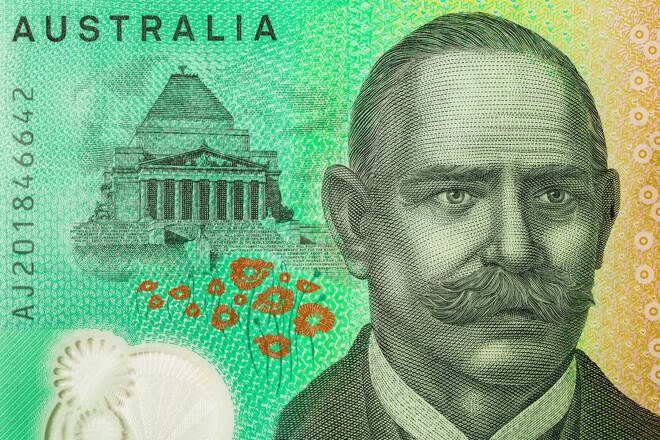Advertisement
Advertisement
AUD to USD Forecast: Aussie Dollar Rises with Boosted Consumer Confidence
By:
With a surge in the Westpac Consumer Confidence Index, demand for the Australian Dollar escalates, easing recession concerns.
Highlights
- The AUD/USD observed a notable 0.42% rise on Monday, recovering from its dip to $0.63427.
- A surprising uptick in Australian consumer confidence boosted demand for the Aussie dollar on Tuesday.
- FOMC member views are pivotal, with some leaning towards an interest rate hike pause.
Monday Overview
The AUD/USD gained 0.42% on Monday. Following a 0.22% rise on Friday, the Aussie dollar ended the day at $0.64104. The Aussie dollar fell to a low of $0.63427 before rising to a high of $0.64148.
Australian Consumer Confidence Improves in October
On Tuesday, an unexpected rise in Australian consumer confidence drove buyer appetite for the Aussie dollar. The Westpac Consumer Confidence Index climbed from 79.7 to 82 in October. Economists forecast a decline to 79.1.
A pickup in consumer confidence is a positive leading indicator for consumer spending. Australian private consumption accounts for more than 50% of the Australian economy. An upward trend in consumer spending would ease recessionary fears and drive demand for the Aussie dollar.
According to the October survey,
- Sentiment toward family finances and house prices improved in October, while the economic outlook remained bleak.
- The ‘time to buy a major household item sub-component jumped 7.6% in October, signaling a willingness to spend.
- Employment expectations and house price expectations also sent favorable signals when considering year-on-year movements.
The remaining sub-components sent mixed signals.
- Family finances vs one year ago reflected the impact of RBA rate hikes on household finances.
- However, the family finances, the next 12 months sub-component brings hope of a possible pickup in consumption and pickup in economic growth. The RBA pause on interest rate hikes likely contributed to the upward trend.
- Nonetheless, economic conditions in the next 12 months indicate a tricky time ahead. However, consumers anticipate an improving economy when considering the economic conditions in the next five years sub-component.
- One uncertainty for consumers remains inflation and RBA monetary policy intentions. Interest rate expectations jumped in October.
Aussie Business Confidence Aligns with Consumer Sentiment Toward Employment
The Australian NAB Business Confidence Index declined by 1 point to +1. Economists forecast the Business Confidence Index to decline to -2 points.
FOMC Member Speeches in Focus
Later today, FOMC member speeches need consideration. FOMC members Christopher Waller, Neel Kashkari, Mary Daly, and Raphael Bostic are on the economic calendar to speak. Voting members Christopher Waller and Neel Kashkari will likely have more influence on investors.
FOMC member views on the economy and interest rate hikes will influence the AUD/USD pair. FOMC members Lorie Logan and Philip Jefferson leaned toward pausing rate hikes on Monday, weighing on the US Dollar.
Beyond the economic calendar, the IMF Economic Outlook Report also needs consideration. A gloomy global economic outlook could weigh on demand expectations and pressure appetite for the Aussie Dollar. News updates from the Middle East will also influence buyer appetite.
Supply chain disruptions would adversely impact global trade terms. The Australian trade-to-GDP ratio is above 50%, leaving the economy, the Aussie Dollar, and the labor market exposed to a prolonged Middle East conflict, or global economic downturn.
Short-Term Forecast
Monetary policy divergence has narrowed in favor of the Aussie dollar. However, uncertainties over the Middle East conflict and the global economic outlook leave the Aussie dollar at risk of a sharp reversal.
AUD/USD Price Action
Daily Chart
The AUD/USD remained below the 50-day and 200-day EMAs, sending bearish price signals.
However, an AUD/USD break above the 50-day EMA would support a move to the $0.64900 resistance level.
Dovish FOMC commentary and an upbeat IMF Economic Outlook Report would offer support. However, news updates from the Middle East must suggest a de-escalation.
A fall below the $0.63854 support level would give the bears a run at the trend line. An escalation in the Middle East conflict would pressure the Aussie Dollar.
A 14-period Daily RSI reading of 50.99 supports an AUD/USD break above the 50-day EMA and a move to the $0.64900 resistance level before entering overbought territory (typically above 70 on the RSI scale).
4-Hourly Chart
The AUD/USD holds above the 50-day EMA while remaining below the 200-day EMA, sending bullish near-term but bearish longer-term price signals.
A break above the 200-day EMA would support a move toward the $0.64900 resistance level.
However, a fall below $0.64 would bring the $0.63854 support level and 50-day EMA into play.
The 14-period 4-Hourly RSI at 62.33 supports an AUD/USD break above the 200-day EMA before entering overbought territory.
About the Author
Bob Masonauthor
With over 28 years of experience in the financial industry, Bob has worked with various global rating agencies and multinational banks. Currently he is covering currencies, commodities, alternative asset classes and global equities, focusing mostly on European and Asian markets.
Did you find this article useful?
Latest news and analysis
Advertisement
